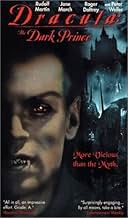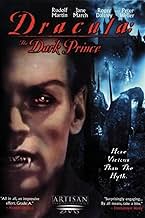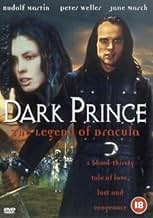Príncipe das Trevas
Título original: Dark Prince: The True Story of Dracula
AVALIAÇÃO DA IMDb
6,0/10
2,8 mil
SUA AVALIAÇÃO
Adicionar um enredo no seu idiomaThe dramatized story of Dracula, looking at the historic events rather than the Hollywood version.The dramatized story of Dracula, looking at the historic events rather than the Hollywood version.The dramatized story of Dracula, looking at the historic events rather than the Hollywood version.
- Prêmios
- 1 indicação no total
Avaliações em destaque
The only problem I had with this movie was the excessive and exaggerated use of the "shaky-cam". This can be an effective took, if used subtly. That was not the case in Dark Prince. I found it very annoying at times and once, it became down-right painful to watch. The good news is that its not always that bad. I enjoyed it and would recommend it for good acting, compelling story line, very good battle scenes, great sets and location shots, and captivating subject matter for those who want intelligent Halloween entertainment.
Some things...
1) Dracula's first wife (whose name has never been historically documented other than known to be a Transylvanian noblewoman) committed suicide in 1462, not 1464, when Dracula was already imprisoned by the King of Hungary anyway. Not sure why the film changed this, really.
2) The impalings... aren't accurate. The oiled stake is put in the buttocks and slowly moves out through the mouth. This takes days, the impalee dying a slow death. We don't see any actual impalings during the movie save one, and the guy slides down the stake like it's a flag pole.
3) While not necessarily portrayed as a nice guy, I was expecting a bit more brutality. Much of Vlad Tepes' acts are brushed aside in the framing story of Dracula being interrogated by the priests in 1476 as "stories" by Dracula himself and this just seems like a kind of cop-out. I realize we don't need to see Dracula cutting the breasts off of women and such, but there was PLENTY of more hard-hitting material that could have been put in there. Example: instead of Dracula just closing the doors and executing the boyars like he does in the film, wouldn't it be far more effective cinematically to follow what *really* happened and show Dracula and his men dragging the boyars to go and build (by themselves) Castle Dracula, which took years and basically worked the lot of them to death? Also would have been effective to show the scene of Dracula rounding up all the homeless and beggars into the grand hall, then having his men burn it to the ground. The only real story of Dracula that was included was the one with the golden goblet that wasn't touched by anyone... that's about it.
4) I realize it was done for dramatic purposes, but the film kept sticking Dracula's broth Radu in places/times he simply wasn't. Dracula was killed in 1476 by a man (a Turk) disguised as one of his own guards... in a MARSH somewhat near Snagov, not inside Snagov Chapel.
5) The ending is neither here or there... I'd rather they didn't go that route, but then the end of Vlad's life is a bit anti-climactic.
1) Dracula's first wife (whose name has never been historically documented other than known to be a Transylvanian noblewoman) committed suicide in 1462, not 1464, when Dracula was already imprisoned by the King of Hungary anyway. Not sure why the film changed this, really.
2) The impalings... aren't accurate. The oiled stake is put in the buttocks and slowly moves out through the mouth. This takes days, the impalee dying a slow death. We don't see any actual impalings during the movie save one, and the guy slides down the stake like it's a flag pole.
3) While not necessarily portrayed as a nice guy, I was expecting a bit more brutality. Much of Vlad Tepes' acts are brushed aside in the framing story of Dracula being interrogated by the priests in 1476 as "stories" by Dracula himself and this just seems like a kind of cop-out. I realize we don't need to see Dracula cutting the breasts off of women and such, but there was PLENTY of more hard-hitting material that could have been put in there. Example: instead of Dracula just closing the doors and executing the boyars like he does in the film, wouldn't it be far more effective cinematically to follow what *really* happened and show Dracula and his men dragging the boyars to go and build (by themselves) Castle Dracula, which took years and basically worked the lot of them to death? Also would have been effective to show the scene of Dracula rounding up all the homeless and beggars into the grand hall, then having his men burn it to the ground. The only real story of Dracula that was included was the one with the golden goblet that wasn't touched by anyone... that's about it.
4) I realize it was done for dramatic purposes, but the film kept sticking Dracula's broth Radu in places/times he simply wasn't. Dracula was killed in 1476 by a man (a Turk) disguised as one of his own guards... in a MARSH somewhat near Snagov, not inside Snagov Chapel.
5) The ending is neither here or there... I'd rather they didn't go that route, but then the end of Vlad's life is a bit anti-climactic.
The biggest reason why i love this movie so much because im from Balkan and Romania is my neighboring country and they are also Orthodox like myself. But thats not the only reason of course, movie was just wonderful (even thought it had low budget), Rudolph Martin was also great, location and music everything, I just loved it so much. The only problem i saw was the cover of the movie. Its very misleading, because this movie is definitely not about bloodsucking creatures, its about a Prince who would do anything to bring justice to his people and his country, even become a catholic, and his actions were seen as fight against God and his soul was condemned forever. Its a must see, especially for the people of Orthodox orgins.
Good try at a Bio of Vlad Tepes but too many historical mistakes of his life. Filmed in Sighisoara Vlad's actual birthplace but they mention that he was born somewhere else. You can actual see the building he was born in, Sighisoara is a beautiful medieval town so filming there was a great idea. Though alot of mistakes were made it was still a good story and a well done film.
I would like to see more Dracula movies based on the actual person. This is the first one I have ever come across. It's nice to see an interpretation on the real person rather than the Hollywood version. Though i wouldn't rely on this movie for true and accurate history, it did appear to stretch it for drama sake. The atmosphere is perfect, dark and haunting in a medieval sort of way. I thought it was amusing how at certain points the movie there were allusions to the common vampire myth (two i recall are about mirrors and driving a stake through Dracula's heart). Those point do spark interest into the real customs and beliefs of that time that formed the myth. I would recommend this movie to those who are at the least mildly interested in history and Dracula. Though it's a little dull at times and the brutality is dumbed down (it is a TV movie), it's a good movie to see when its on TV.
Você sabia?
- CuriosidadesIn 2000, to promote the film's premiere, USA Network held a sweepstakes contest with a grand prize of $5,000 to the lucky person who can correctly identify five myths of Dracula as depicted in this film.
- Citações
Radu: You are going to kill me, aren't you?
Vlad Dracula: You are a traitor to your people. You betrayed our father!
Radu: I never betrayed our father! Besides, if it weren't for me, you'd still be in that Turk prison.
Vlad Dracula: You had that much influence over the Sultan? Even as a boy?
Radu: Especially as a boy.
- Trilhas sonorasLa Scarpa My Faict Mal
Written by Bernard Solomon (as J. Baird) and Frank Gari (as F. Gari)
Principais escolhas
Faça login para avaliar e ver a lista de recomendações personalizadas
Detalhes
- Data de lançamento
- Países de origem
- Idioma
- Também conhecido como
- Dracula: The Dark Prince
- Locações de filme
- Empresas de produção
- Consulte mais créditos da empresa na IMDbPro
Contribua para esta página
Sugerir uma alteração ou adicionar conteúdo ausente



























